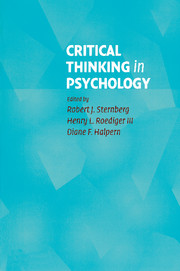Book contents
- Frontmatter
- Contents
- List of Illustrations and Tables
- List of Contributors
- Preface
- 1 The Nature and Nurture of Critical Thinking
- 2 Evaluating Experimental Research
- 3 Critical Thinking in Quasi-Experimentation
- 4 Evaluating Surveys and Questionnaires
- 5 Critical Thinking in Designing and Analyzing Research
- 6 The Case Study Perspective on Psychological Research
- 7 Informal Logical Fallacies
- 8 Designing Studies to Avoid Confounds
- 9 Evaluating Theories
- 10 Not All Experiments Are Created Equal
- 11 Making Claims in Papers and Talks
- 12 Critical Thinking in Clinical Inference
- 13 Evaluating Parapsychological Claims
- 14 Why Would Anyone Do or Believe Such a Thing?
- 15 The Belief Machine
- 16 Critical Thinking and Ethics in Psychology
- 17 Critical Thinking in Psychology
- Author Index
- Subject Index
- References
14 - Why Would Anyone Do or Believe Such a Thing?
A Social Influence Analysis
Published online by Cambridge University Press: 05 June 2012
- Frontmatter
- Contents
- List of Illustrations and Tables
- List of Contributors
- Preface
- 1 The Nature and Nurture of Critical Thinking
- 2 Evaluating Experimental Research
- 3 Critical Thinking in Quasi-Experimentation
- 4 Evaluating Surveys and Questionnaires
- 5 Critical Thinking in Designing and Analyzing Research
- 6 The Case Study Perspective on Psychological Research
- 7 Informal Logical Fallacies
- 8 Designing Studies to Avoid Confounds
- 9 Evaluating Theories
- 10 Not All Experiments Are Created Equal
- 11 Making Claims in Papers and Talks
- 12 Critical Thinking in Clinical Inference
- 13 Evaluating Parapsychological Claims
- 14 Why Would Anyone Do or Believe Such a Thing?
- 15 The Belief Machine
- 16 Critical Thinking and Ethics in Psychology
- 17 Critical Thinking in Psychology
- Author Index
- Subject Index
- References
Summary
In the 1920s and 1930s, Oscar Hartzell conned untold millions of dollars from Americans mostly living in the Midwest (Rayner, 2002). His scam: Hartzell claimed to be heir to the Drake fortune – a multibillion dollar trust fund left by the famed explorer Sir Francis Drake. The catch: The British government refused to release those funds without a legal fight. Hartzell invited investors to help pay for the legal fees, and in return they would share the fortune upon victory in court. In the 1980s, Dr. John Ackah Blay-Miezah raked in over $250 million by using the same basic scheme (Jackman, 2003). Blay-Miezah claimed to be the sole beneficiary of the $27 billion Oman Ghana Trust created by Kwame Nkrumath, first president of Ghana, with money from his illicit smuggling operations. Of course, the fund was secret, the financial dealings complex, and thus Blay-Miezah needed investors to help him hire lawyers to release the funds. Blay-Miezah promised a 1,000% return on investment. Every year, Americans lose over $55 billion in telemarketing, investment, and charity scams (Pratkanis & Shadel, 2005).
In 1997, 36 men and women of a California group known as Heaven's Gate dressed in purple shrouds, black pants, and black tennis shoes and killed themselves to board a UFO tailing the comet Hale–Bopp. In 1995, members of Aum Supreme Truth placed bags of leaking sarin gas in the Tokyo subway system, killing 12 persons and injuring more than 5,500.
- Type
- Chapter
- Information
- Critical Thinking in Psychology , pp. 232 - 250Publisher: Cambridge University PressPrint publication year: 2006
References
- 1
- Cited by

